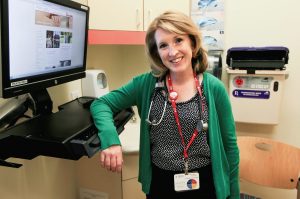Medical Scribes
 Recently I reviewed an emergency department record which included the name of the scribe. Then I read an article in the Dome, a publication of Johns Hopkins, about the benefits of using medical scribes in the Emergency Department. The medical record I reviewed was handwritten by a medical scribe. Johns Hopkins’ scribes enter data into the computer.
Recently I reviewed an emergency department record which included the name of the scribe. Then I read an article in the Dome, a publication of Johns Hopkins, about the benefits of using medical scribes in the Emergency Department. The medical record I reviewed was handwritten by a medical scribe. Johns Hopkins’ scribes enter data into the computer.
How common are scribes? Johns Hopkins asserted that an estimated 12,000 scribes are documenting work for physicians in hospitals and clinics.
Who are medical scribes?
ScribeAmerica says a scribe is a physician collaborator who fulfills the primary secretarial and non-clinical functions of the busy physician or mid-level provider. “Scribes specialize in medical data entry into a paper or electronic medical record system and in instituting efficient workflow process, thus increasing the medical provider’s capacity to provide direct patient care like seeing the next waiting patient, performing medical procedures and communicating with nursing staff. The scribe actively monitors the duration of medical testing results such as blood and urine tests, x-ray, and CT reports in order to prevent unnecessary delays and expedite patient dispositioning.”
Now, this is interesting. While I thought of medical scribes as people who record data on behalf of a physician, I see they have a role in expediting testing. How far does that role go?
Scribesolutions offers an even more expanded role: “Our scribes also perform other emergency department services such as tracking labs, transcribing radiology reports, attending to patient needs, and helping physicians organize data.”
Being a scribe may be a stepping stone for people who are interested in becoming nurse practitioners, physician assistants or physicians. Scribeconnect asserts that most physician assistant programs will accept scribe hours as counting towards the 2000 hour requirement for PA school.
How are scribes trained?
My review of websites that provide scribe training shows that they can be high school graduates who receive training in documentation. Scribe America describes their training program:
“The medical scribe training program consists of 3 steps:
- Step 1 is a 2-week orientation course designed to get the medical scribe “up to speed” for his first day of collaboration with the physician.
- Step 2 is supervisory period during which a highly experienced medical scribe offers immediate review and feedback of the new medical scribe’s work.
- Step 3 is a periodic re-assessment that allows for indefinite and frequent review of the scribe’s role and effectiveness in an effort to enable the medical scribe to always keep up-to-date with a dynamic workplace environment.”
Scribeconnect offers an onsite 3 day program to convert LPNs, RNs, medical assistants, techs or other office staff into scribes to help the physician “with the time consuming task of medical documentation”.
Three days turns a medical assistant into a scribe? Really? Then who does the work the staffer used to do? Or does the office staff have to double up and scribe as well as perform other tasks?
Various websites I checked offered simultaneously the ability of physicians to see more patients in a day, plus that patients would have more face to face time with the physician. This seems to be a bit of a contradiction to me.
All of this made me think about the time I worked on a neurosurgical unit. Our head nurse loaded charts up on a rack and followed the neurosurgeons while they made rounds. The physician would examine the patient, toss a few orders at the head nurse, who would dutifully document them as verbal orders, and then be onto the next patient. The physicians loved it until the nursing department put an end to the practice. Today’s medical scribe would document the whole encounter, maybe not the orders, although who knows?
As legal nurse consultants, we should be attentive to documentation that states that someone other than the physician entered the information into the medical record. What are the legal implications if that information is incorrect? Johns Hopkins says the physicians are required to review and sign off on the documentation entered by scribes. I hope that is not a step that physicians omit. The distraction, noise, accents and other factors that affect communication could result in inaccurate information documented by a scribe. The buck has to stop at the doctor’s door.
Pat Iyer is president of the Pat Iyer Group. She’s not worked with a scribe and is curious about the accuracy of this assistant.
Grab your free copy of 5 Surefire Ways to Get More Clients.
